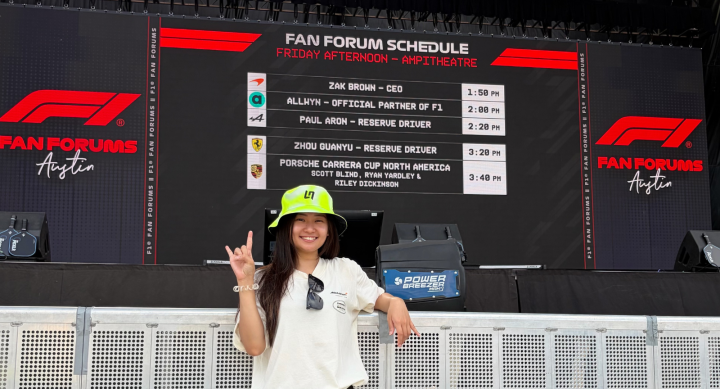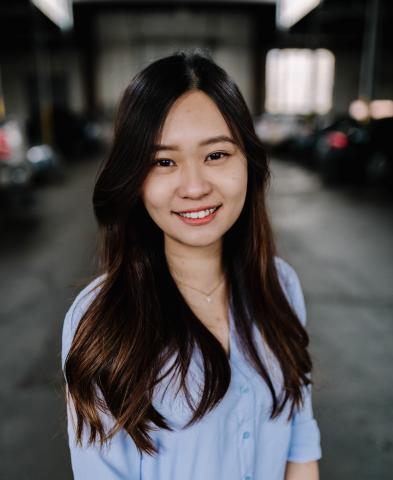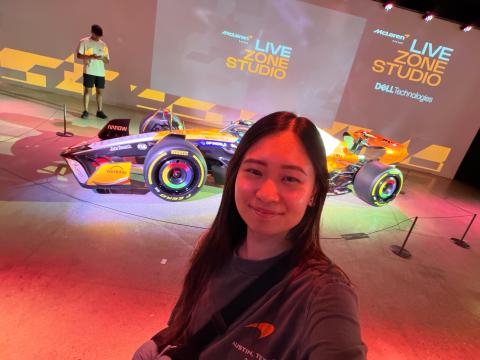
From viral memes and BookTok fandoms to Formula 1 drama and social media crises, Andrea Lim is turning internet culture into academic inquiry. A second-year Ph.D. student in the Stan Richards School of Advertising and Public Relations at UT Austin, Lim brings a unique lens to the intersection of fandom, identity and digital communication.
An international student, Lim combines her personal interests with scholarly depth, exploring how parasocial relationships, online communities and branding influence consumer behavior and public perception. With a strong foundation in strategic communication and a passion for storytelling, she’s carving a path that bridges pop culture and impactful research.
Lim is currently working on several research projects, including one that examines the growing popularity of sports romance novels on TikTok and Instagram. Even without watching a single game, readers often form strong emotional connections to fictional athletes and sports teams. These online book communities can even spark real-life sports interest, such as attending games or following teams. The findings challenge the idea that sports fandom must begin in a stadium—sometimes, it can begin in a story. She believes this could support the surge in female fans in recent years.
Another project focuses on Formula 1 drivers as both athletes and personal brands. She studies how fans respond when a driver faces public criticism and addresses it on social media, testing two crisis communication approaches: downplaying the situation or fully apologizing. She also looks at how a fan’s emotional closeness to the driver influences forgiveness, attitudes and loyalty. Early results suggest that these relationships can make certain crisis responses more effective, offering insights for how public figures can better manage their reputations online.

We sat down with Lim to talk more about her work, her inspiration and her hopes for the upcoming U.S. Grand Prix.
Can you tell us about your research and what attracted you to your area of study?
My research focuses on fandom cultures, social media, crisis communication, sports media and consumer behavior. While I’ve always been interested in strategic communication and social media, my path to pursuing a Ph.D. really took shape through my passion for Formula 1. What began as a casual interest quickly turned into a curiosity about how public figures navigate authenticity, branding and fan relationships online. After a year in this program, I realized that much of my inspiration comes from the communities and cultures I encounter in my social media algorithm. My feeds are full of content about F1, K-pop, BookTok, pets, Pilates and C- and K-dramas (often in the form of memes), which might seem purely for fun at first glance. But what fascinates me is how these digital spaces foster belonging, spark conversations and create intricate webs of fan interactions that mirror close-knit communities. Studying these dynamics allows me to combine my personal passions with meaningful research on how fandom, identity and engagement intersect in the digital age.
Why did you decide to attend UT?
I chose UT because it offered the ideal combination of world-class faculty, a strong research culture and opportunities for professional growth. The faculty’s expertise, particularly Dr. Natalie Brown-Devlin’s work, aligns closely with my interests in fandom, sports and crisis communication. The program is also well-rounded, allowing me to grow as a scholar through my own research, contribute to collaborative projects and gain valuable teaching experience as a TA and future Assistant Instructor. At UT, I truly feel like what I start here can change the world.
How has UT helped you further your interests and goals?
UT has given me the resources, mentorship and community to take my research from an idea to a tangible body of work. Through my TA role, I’ve also developed as an educator, learning how to create engaging classroom experiences while mentoring undergraduates. The collaborative environment at UT, combined with access to research centers and interdisciplinary networks, has pushed me to think bigger about how my work can create impact.
What has been your research methodology for determining the effectiveness of crisis communication and how do you define and measure “emotional closeness?”
In my pilot study, I ran an experiment using a 2x2 factorial design to test how different types of public responses from Formula 1 drivers—like giving a justification versus a heartfelt apology—affect the way fans react to them after a scandal or mistake. I focused on three key outcomes: brand forgiveness, fan attitudes and loyalty toward the driver.
To define and measure emotional closeness, I used the concept of parasocial interaction (PSI)—that feeling of intimacy or friendship fans can feel toward a public figure, even if they’ve never met them in real life. Think of how some fans feel like they “know” a favorite athlete or celebrity just from watching interviews or following them on social media.
Participants in my study answered a few questions about how close they felt to the driver before seeing a fictional crisis scenario and the driver’s response. This helped me see whether emotionally “closer” fans responded more favorably, and whether emotional closeness makes a difference in how fans react when things go wrong.

If emotional closeness has the potential to influence forgiveness, attitudes and loyalty in the face of public criticism, has it been suggested in your research how F1 drivers can encourage or facilitate emotional closeness with their fans?
While my study did not test specific tactics for building parasocial relationships, the findings suggest that this emotional closeness can play a meaningful role in shaping how forgiving and loyal fans are when their favorite driver faces public criticism. This opens the door for teams and drivers to think more intentionally about how they build and maintain these emotional bonds over time.
Some of the most effective examples are not grand gestures, but consistent and human ones. I’ve seen several great examples on the current grid. Carlos Sainz, for instance, regularly shares personal reflections with fans after each race, whether the result is podium-worthy or not. This kind of vulnerability, where he offers fans a window into his mindset, builds trust and relatability.
The Visa Cash App Racing Bulls team has also done an outstanding job this season. Their behind-the-scenes content with Liam Lawson and Isack Hadjar blends humor, current trends and a strong sense of team chemistry. Their social media presence feels like a group of real people having fun together, not just a performance for the cameras. When fans get to see the personalities behind the helmets, it helps emotional closeness develop more naturally. This, in turn, makes fans more likely to stay loyal through both the highs and the lows.
While parasocial bonds are one-sided by nature, the content that fosters them tends to be rooted in authenticity, emotional honesty and routine engagement. I’m glad to see more F1 teams and drivers embracing this approach.
The U.S. Grand Prix races into Austin on October 19. Will you be seated at the Circuit of the Americas, and do you have any hopes or predictions for the race?
I will be attending the US Grand Prix!
As for predictions, I dare not jinx anything or offend any passionate fans, but I will say that as a fellow papaya fan, I’d love to see both Lando Norris and Oscar Piastri on the podium—both in the Sprint and the Race. I’m also excited to see how the rookies and underdogs perform on our track this year. Here’s to hoping we get an exciting, drama-filled race weekend worthy of the Austin atmosphere!

